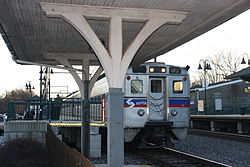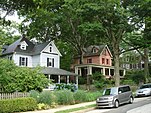Warminster Line
| Warminster Line | |||
|---|---|---|---|
 Northbound Warminster Line train leaving the Melrose Park station in Cheltenham | |||
| Overview | |||
| Status | Operating | ||
| Termini | |||
| Stations | 17 | ||
| Website | septa.org | ||
| Service | |||
| Type | Commuter rail line | ||
| System | SEPTA | ||
| Operator(s) | SEPTA Regional Rail | ||
| Rolling stock | Electric Multiple Units | ||
| Technical | |||
| Track gauge | 4 ft 8+1⁄2 in (1,435 mm) standard gauge | ||
| |||
The Warminster Line is a route of the SEPTA Regional Rail commuter rail. It serves stations between its namesake town, Warminster, and Center City, Philadelphia. Half of the route is shared by other lines, including the Lansdale/Doylestown Line, West Trenton Line, Fox Chase Line, Chestnut Hill East Line, and Manayunk/Norristown Line.
History and route
The Warminster Line uses the SEPTA Main Line between Center City and Glenside, where it branches off onto its own line to Hatboro and Warminster. The tracks continue past Warminster to Ivyland and eventually to New Hope, where the New Hope & Ivyland Railroad runs heritage excursion trains.
North of Glenside the line was built by the Northeast Pennsylvania Railroad, first opened November 9, 1873 from Glenside on the North Pennsylvania Railroad to Ivyland. The rest of the line to New Hope opened April 29, 1891. The North Pennsylvania Railroad was later taken over by the Philadelphia & Reading Railroad, later Reading Lines (RDG). Electrified service via pantagraph wires opened to Hatboro July 26, 1931 (along with Doylestown on RDG's Doylestown Branch, West Trenton on RDG's New York Division, and Landsdale, a junction where RDG's North Penn Branch and Doylestown Branch merge). In the days of passenger service on what was originally labeled by the RDG as the New Hope Branch, as many as 10 trains a day would make round trips on the line.
In 1952, all passenger service ceased north of Hatboro to New Hope, with every station except Rushland, Wycombe, Lahaska and New Hope being demolished in 1954. Between 1952 and 1966, only freight trains traveled north of Hatboro to serve customers in Warminster, Ivyland, Rushland, Buckingham and New Hope. In 1966, the New Hope & Ivyland Railroad (NHIR) was launched and purchased 16 miles of track from Ivyland to New Hope. After 1966, Ivyland served as a freight interchange between RDG and NHIR and the RDG relabeled their remaining ownership of the line as the Warminster Branch. Not only did they transport freight, but also run scenic heritage excursions, originally from New Hope to Buckingham, but has been cutback to Lahaska in the 1980s. However, passenger service between Warminster and Hatboro was still inactive.
In 1971, RDG filed for bankruptcy after a variety of misfortunes; among them are increased use of trucks and a dwindling economy. The court issued a bankruptcy protection so RDG can still operate. On July 29, 1974, passenger service was reinstated after RDG completed an extension of the electrification from Hatboro (the original electrified terminus) to Warminster. Willow Grove and Warminster stations were also rebuilt in the same year. By that time, executives of RDG didn't see their debt becoming any better. Less than two years later, RDG's rolling stock, right-of-ways, interests and stock were in the hands of Conrail, also known as the Consolidated Rail Corporation, which launched operations on April 1, 1976. In 1983, SEPTA took control of the Warminster Branch.
The Warminster Line becomes a single-track line just north of Ardsley, but was once double-tracked as far north as Roslyn, the original northbound track being removed in 2010. A passing siding exists north of Willow Grove.
The majority of weekday and all weekend Warminster trains operate through the Center City tunnel and run to or from the Airport Line, providing service to University City, Eastwick, and Philadelphia Int'l Airport stations.
Name change

On July 25, 2010 SEPTA renamed the service from the R2 Warminster to simply the Warminster Line as part of system-wide service change that drops the R-number naming and makes the Center City stations the terminus for all lines. This also ended the combined R2 Newark/R2 Warminster service.[1]
Station list
Boldface indicates a major station.
| Zone | Milepost | Station | Boardings[2] | City/Township | County | Notes |
|---|---|---|---|---|---|---|
| C | 2.1 | Temple University | 3,028 | Philadelphia | Philadelphia | all lines; high-level platforms |
| 1 | 5.1 | Wayne Junction | 527 | also West Trenton Line, Lansdale/Doylestown Line, Chestnut Hill East Line and Fox Chase Line | ||
| 7.3 | Fern Rock Transportation Center | 825 | also West Trenton Line and Doylestown Line; high-level platforms | |||
| 2 | 8.4 | Melrose Park | 458 | Cheltenham | Montgomery | also West Trenton Line and Doylestown Line |
| 9.2 | Elkins Park | 632 | also West Trenton Line and Doylestown Line | |||
| 3 | 10.8 | Jenkintown-Wyncote | 1,998 | Cheltenham/Jenkintown | also West Trenton Line and Doylestown Line Aerial photo | |
| 11.9 | Glenside | 1,068 | Cheltenham | also Doylestown Line | ||
| 13.0 | Ardsley | 175 | Abington | |||
| 14.2 | Roslyn | 198 | ||||
| 15.4 | Crestmont | 89 | ||||
| 16.2 | Willow Grove | 472 | Upper Moreland | |||
| Fulmor | closed November 10, 1996[3] | |||||
| 18.6 | Hatboro | 457 | Hatboro | End of electrification until 1974 | ||
| 20.1 | Warminster | 1,295 | Warminster | Bucks | high level platform |
Ridership
| Fiscal year | Average weekday | Annual passengers |
|---|---|---|
| FY 2013 | 8,580 | 2,501,832[4] |
| FY 2012 | 8,492 | 2,476,132[5] |
| FY 2011 | 9,130 | 2,662,200[6] |
| FY 2010 | 9,139 | 2,715,105[7] |
| FY 2009 | 8,590 | 2,551,344[8] |
| FY 2008 | 8,139 | 2,418,100[9] |
| FY 2005 | 7,161 | 2,061,395 |
| FY 2004 | 7,651 | 2,147,531 |
| FY 2003 | 7,770 | 2,048,300 |
| FY 2001 | n/a | 2,046,000 |
| FY 2000 | n/a | 2,079,000 |
| FY 1999 | n/a | 1,794,000 |
| FY 1997 | n/a | 1,805,371 |
| FY 1996 | n/a | 1,800,748 |
| FY 1995 | 6,416 | 1,757,197 |
| FY 1994 | 5,866 | 1,369,173 |
| FY 1993 | 4,485 | 1,027,837 |
| Note: n/a = not available | ||
References
- ^ "List of new SEPTA schedules".
- ^ "Fiscal Year 2015 Annual Service Plan" (PDF). SEPTA. May 2014.
- ^ "SEPTA Board Cuts Service; But Opposition is Spirited". The Philadelphia Daily News. October 25, 1996. p. 12. Retrieved July 19, 2011.
- ^ Template:PDFlink
- ^ Template:PDFlink
- ^ Template:PDFlink
- ^ http://www.septa.org/reports/pdf/asp12.pdf
- ^ http://www.septa.org/reports/pdf/asp11.pdf
- ^ http://www.septa.org/reports/pdf/asp10.pdf




